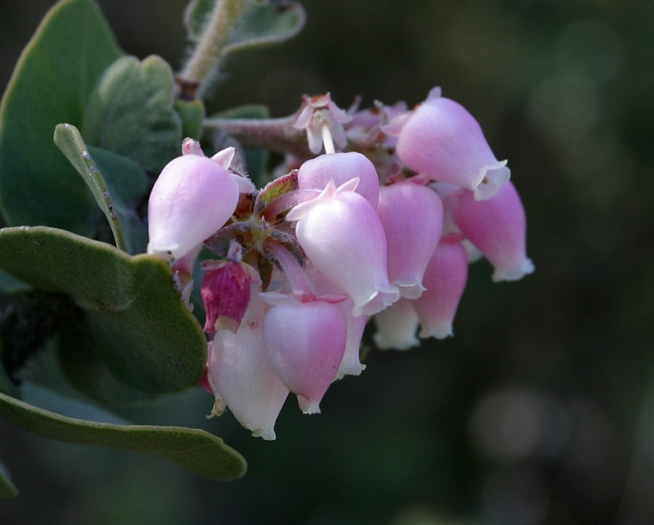Mount Diablo Manzanita
(Arctostaphylos auriculata)
Mount Diablo Manzanita (Arctostaphylos auriculata)
/
/

Steve Matson
CC BY 4.0
Image By:
Steve Matson
Recorded By:
Copyright:
CC BY 4.0
Copyright Notice:
Photo by: Steve Matson | License Type: CC BY 4.0 | License URL: http://creativecommons.org/licenses/by/4.0/ | Rights Holder: Steve Matson | Publisher: iNaturalist | Date Created: 2006-02-12T13:49:19-08:00 |

























Estimated Native Range
Summary
Arctostaphylos auriculata, commonly known as Mount Diablo manzanita, is an endangered evergreen shrub endemic to chaparral and foothill woodlands of Mount Diablo in Contra Costa County, California. It is typically found at elevations of 492-2133 feet on sandstone-derived soils. This slow-growing shrub reaches heights of 3-15 feet and has a distinctive appearance with serpentine, glandless stems covered in white hair. The leaves are short, silvery, and oval-shaped, contributing to the plant’s unique texture. From February to May, it produces dense clusters of white urn-shaped flowers that are attractive to pollinators, followed by small, hairy berries that are a food source for local wildlife.
Mount Diablo manzanita is valued for its striking silver foliage and showy white flowers, making it a desirable addition to native plant gardens and restoration projects within its range. It requires well-drained soils, preferably derived from sandstone, and thrives in full sun to part shade conditions. Due to its adaptation to a specific microclimate and soil type, it can be challenging to cultivate outside its native range. It does not possess a basal burl, which in other manzanita species allows them to resprout after fire; therefore, it relies solely on seed for propagation. Gardeners should be cautious of its proximity to poison oak, which often grows in the same areas. While it is not known for aggressive roots or major diseases, its limited distribution and specific habitat requirements make it vulnerable in the wild.CC BY-SA 4.0
Mount Diablo manzanita is valued for its striking silver foliage and showy white flowers, making it a desirable addition to native plant gardens and restoration projects within its range. It requires well-drained soils, preferably derived from sandstone, and thrives in full sun to part shade conditions. Due to its adaptation to a specific microclimate and soil type, it can be challenging to cultivate outside its native range. It does not possess a basal burl, which in other manzanita species allows them to resprout after fire; therefore, it relies solely on seed for propagation. Gardeners should be cautious of its proximity to poison oak, which often grows in the same areas. While it is not known for aggressive roots or major diseases, its limited distribution and specific habitat requirements make it vulnerable in the wild.CC BY-SA 4.0
Plant Description
- Plant Type: Shrub
- Height: 3.5-12 feet
- Width: 3.5-12 feet
- Growth Rate: Moderate
- Flower Color: Pink, White
- Flowering Season: Spring, Winter
- Leaf Retention: Evergreen
Growth Requirements
- Sun: Full Sun, Part Shade
- Water: Low
- Drainage: Medium, Fast
Common Uses
Bee Garden, Bird Garden, Drought Tolerant, Low Maintenance, Showy Flowers
Natural Habitat
Endemic to chaparral and foothill woodlands surrounding Mount Diablo in Contra Costa County, California
Other Names
Common Names: Mt. Diablo Manzanita, Eared Manzanita
Scientific Names: , Arctostaphylos auriculata, Arctostaphylos andersonii var. auriculata, Uva-ursi auriculata,
GBIF Accepted Name: